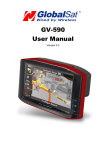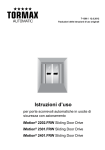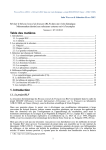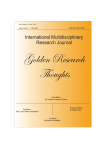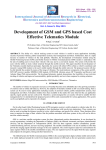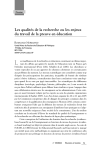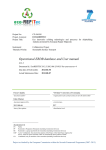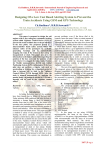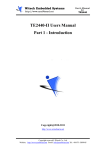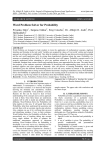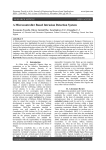Download Design of Public Transport Service System Based on Short Message
Transcript
Mohammad.Iliyas Ahmed, B.Chakradhar / International Journal of Engineering Research and Applications (IJERA) ISSN: 2248-9622 www.ijera.com Vol. 3, Issue 1, January -February 2013, pp.250-252 Design of Public Transport Service System Based on Short Message Service Mohammad.Iliyas Ahmed, B.Chakradhar PG student, Department of Electronics and Communication Engineering, CMR College of Engineering and Technology, Hyderabad, AP, India. Assistant Professor, Department of Electronics and Communication Engineering, CMR College of Engineering and Technology, Hyderabad, AP, India Abstract (ARM), Global system for Mobile communications (GSM), pen drive, short message service (SMS) and S3C2440A. interesting point here is no need to keep man power to attend all calls. The data services have been gained popularity in cellular networks. Short message service (SMS) is best application in data services. SMS is quite simple and the maximum message’s length is 160 characters. SMS uses only a set of characters as data type. In this paper we study the embedded system theory, short message service (SMS), communication technology and GSM technology. In this paper, we combine GSM technology and computer technology. The purpose is to design the public transport system based on SMS.As all we know there are so many stops in the big cities, which bus will go which stops and Bus numbers and timings will be kept in the database. All the bus stops and bus timings will be kept in the data Base. We put forward the block diagram and design. I. INTRODUCTION II. METHODOLOGY In this paper, we proposing the simple public bus transport query system based on short message service (SMS). Here we analysis embedded system theory and short message service (SMS). We are combining communication technology and GSM technology. Whole traffic routes and timing information is kept in USB per drive and connected to S3C2440A, it communicates with GSM and responds to the queries by getting the information from its USB port pen drive.GSM will reply to those queries by using AT commands. We put forward the system principle block diagram and the hardware circuit of GSM. Keywords: - Advance RISC Machine In modern world, embedded systems have become an indispensable part of our life. Use of embedded systems has become so common in our day to day life that every one of us uses them (no matter if we are aware or not). Today 98% of all processors Produced are used in Embedded Systems. Because of their power saving features, ARM CPUs are dominant in the mobile electronics market, where low power consumption is a critical design goal. In the existing method if anyone needs information about any transportations information we have to contact that through call for necessary solution. And then we need to explain what information we require to the operator. Receiving the call by the operator is an optional one so we need wait until they responds to our call for the information we require. In the present method we can find the solution to the previous method. By using this model there is no need of making calls to get information and no need wait for response from the other side. And by this method we can just send message at any time (24X7). It consists of internal data inside the database regarding the general information required for the customer. The most In our paper we making use of 3 basic things those are ARM9 that is S3C2440A, GSM module and to keep all the data we have Pen drive. In the basic Block diagram we have ARM9 Microcontroller, GSM module and Pen drive. We use RS232 to connect the S3C2440A board and GSM module. REGULATED POWER SUPPLY GSM MODEM S3C2440A 32-bit Microcontroller USB PEN DRIVE MOBILES Fig 1. 250 | P a g e Mohammad.Iliyas Ahmed, B.Chakradhar / International Journal of Engineering Research and Applications (IJERA) ISSN: 2248-9622 www.ijera.com Vol. 3, Issue 1, January -February 2013, pp.250-252 A. S3C2440A microcontroller. As shown the block diagram in Fig 1. We use the latest SAMSUNG’s S3C2440A. Its low power, simple, elegant and fully static design is particularly suitable for cost- and power-sensitive applications. It adopts a new bus architecture known as Advanced Micro controller Bus Architecture (AMBA). The S3C2440A offers outstanding features with its CPU core, a 16/32-bit ARM920T RISC processor designed by Advanced RISC Machines, Ltd. The ARM920T implements MMU, AMBA BUS, and Harvard cache architecture with separate 16KB instruction and 16KB data caches, each with an 8-word line length. By providing a complete set of common system peripherals, the S3C2440A minimizes overall system costs and eliminates the need to configure additional components. Mini2440 have two flashes, one is the NOR flash, model SST39VF1601, size 2 Mbytes. The other is the NAND flash, model K9F1208, size 64 Mbytes. S3C2440 support both flash to start the department of EC, by DIP switch S2, you can choose from NAND or NOR for your system. Most of the actual products using a NAND flash chip are enough, because we learn for the convenience of users, it also retains the NOR flash. NAND flash does not have the address line, it has a dedicated control interface connected with the CPU, for the 8-bit data bus, but this does not mean that NAND flash read and write data will be very slow. Most of the USB or SD cards are made of NAND flash equipment. NOR flash used a total of A1-A22 address bus 22 and 16 data connected with the CPU bus, please note the address is started from the A1, which means that each time it is the smallest unit of read and write 2-byte. B. SMS SMS is an improved paging service using the GSM capability to send alphabetic/numeric data.Fig.2 illustrates the SMS network architecture, When a handset sends out an SMS, the short message service center (SMSC) will relay this data to the SMS–gateway mobile switching center (SMS–GMSC).The SMS–GMSC will then access the home location register (HLR), search to locate the cellular phone address at the end point, and send route information to the mobile switching center (MSC).After receiving this data, the MSC will determine which SMSC to contact for this end point. If the caller is on roaming mode, SMS– interworking mobile switching center (SMS– IWMSC) will be the message’s next stop. Fig 2. C. GSM Global system for mobile communication (GSM) is a globally accepted standard for digital cellular communication. GSM is a common European mobile telephone standard for a mobile cellular radio system operating at 900MHz. Throughout the evolution of cellular telecommunications, various systems have been developed without the standardized specifications resulting in many problems directly related to compatibility. The GSM standard is intended to address these problems. In the current work, SIM300 GSM module is used. The SIM300 module is a Tri-band GSM solution in a compact plug in module featuring an industry-standard interface. It delivers voice, data and fax in a small form factor with low power consumption. A service unique to GSM, the Short Message Service, allows users to send and receive point-to-point alphanumeric messages up to a few tens of bytes. It is similar to paging services, but much more comprehensive, allowing bi-directional messages, store-and-forward delivery, and acknowledgement of successful delivery. We use Siemens Company’s SIM300 as GSM modem. This module supply 9-pin normal RS-232 interface, in order to full duplex, it should connect MAX3232 to S3C2410 UART1 port through level conversion chip. GSM baseband processor is the core part of SIM300 and deal with the AT command which send from serial port.U211 is the GSM SIM card. The diagram of GSM hardware circuit is illustrates in Fig.3. 251 | P a g e Mohammad.Iliyas Ahmed, B.Chakradhar / International Journal of Engineering Research and Applications (IJERA) ISSN: 2248-9622 www.ijera.com Vol. 3, Issue 1, January -February 2013, pp.250-252 IV.CONCLUSION In this paper, we introduced a new SMS based mobile Automation System. In the last 2 years we found that Short Message Service (SMS) has become the most common communications Channel. By using this SMS feature we developed perfect automated enquiry system for public Bus transformation, this can be used continuously (24X7). we analysis the embedded system theory, short message service (SMS),and combine with the latest computer technology, network technology, communication technology and GSM technology, This proposed technique is well suited for various applications and has good prospects. Fig .3 3. IMPLEMENTATION Linux device driver can be divided into the following parts: Registration and cancellation of the driver; Opening and releasing the device; Reading and writing the device; Controlling the device; the interrupts of device and the cyclic process. Embedded Linux kernel which already contains many source codes of general purpose hardware device driver for different hardware platforms, they are only needed to be done some simple modifications and then can be used. For some of the more special equipments (such as the camera drive), you need a detailed understanding of the hardware and then finish the driver development. Linux provides a unified programming interface for the USB pendrive.In this paper, the USB pen drive device file is primary to store the information of the queries for the corresponding programs. We first go on initialization :system initialization, MMU initialization; system clock initialization; setup Nand Flash register; S3C2410’s GPIO initialization; selection serial port 1; setup baud rate is 115 200. Then respectively call GSM module initialization. Port 1 receiving interruption function, GSM command function and GSM sending message function etc. GSM module initialization. After system started, it needs to initialize, such as: serial port 1 initialization; enable serial port 1 receiving interrupt. GSM command function: GPRS communicate with S3C2410’s port 1, send AT command char to GSM through port 1 and show through port 1. Open port 1 and receive interruption signal. GSM sending message function: send a message to * mobile phone whose number is *number, parameter explanation: *number is the destinations number which will receive message; *text is the sending message content. REFERENCES [1]. [2] [3] [4] [5] [6] Samsung. S3C2440A 32Bit CMOS Microcontroller User's Manual [Z]. Samsung Electronics Corp, 2003. Chwan-Lu Tseng,Joe-Air Jiang,etc. Feasibility study on application of GSM– SMS technology to field data acquisition, Computers and Electronics in Agriculture,2006,53,45–59 Ke Wan. An sms-based sales reporting system for a fashion-clothes franchising company. In Engineering Management Conference, 2003. IEMC ’03. Managing Technologically Driven Organizations: The Human Side of Innovation and Change, pages 330 – 334, 2003. Garner, P., Mullins, I., Edwards, R., and Coulton, P. Mobile terminated sms billing exploits an security analysis. In Third International Conference on Information Technology: New Generations, 2006. ITNG 2006., pages 294–299, April 2006. Guifen Gu; Guili Peng , The survey of GSM wireless communication system, Computer and Information Application (ICCIA), 2010 Oancea, C.D., GSM infrastructure used for data transmission, Advanced Topics in Electrical Engineering (ATEE), 2011 7th International Symposium on 12-14 May 2011 [7] [8] Peersman,C.,Cvethovic,S.,Griffiths,P.,Spe ar,H,The global system for mobile communication short message service. 2000,7,15–23. Karim Yaghmour, “Building Embedded Linux systems,” O'Reilly Media 252 | P a g e




